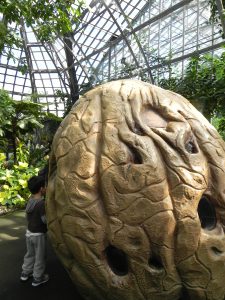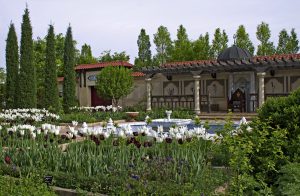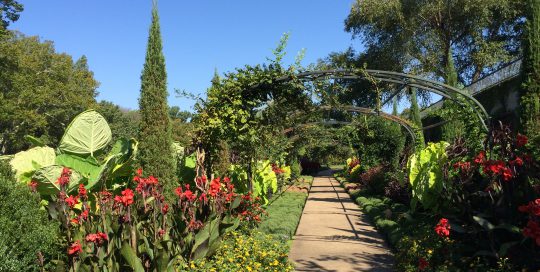The American Horticultural Society lists more than 300 public gardens in the U.S. and Canada, so chances are, there is one in your state, or a place you often vacation. Many, by virtue of their presence in a mild climate, are worth a visit year-round. In less temperate regions, public gardens with conservatories and meticulously-designed landscapes are enjoyable destinations any time of year. Most public gardens feature special displays that will leave you breathless, one of a kind sculptures and well-planned landscape features. All are great spots to gather inspiration, information, ideas, photos, and even souvenirs. In this article, we explore three public gardens that are especially worth visiting in early spring.
Atlanta Botanical Garden (1345 Piedmont Ave. NE, Atlanta, GA 30309, phone 404-591-1550)
As public gardens go, the Atlanta Botanical Garden is a youngster, celebrating its 40th anniversary in 2016. The event was marked with a Chihuly glass exhibit, plant collections, art exhibitions specifically designed for gardens, and specialty gardens to rival the earliest American gardens.
In spring, bulb displays at the garden dazzle. In early March the bulbs emerge — 80,000 strong — with powerful pops of color in the form of daffodils, crocuses and hyacinths. A short while later, the early and mid-season tulips show off their charms. This year’s color theme is red, peach, purple and yellow.
In the Levy Parterre section of the garden, you’ll find 5,000 more tulips than in years past. Varieties include ‘Orange Queen, ‘Orange Emperor’, and ‘Big Smile’. Among the last of the spring bulbs to arrive are 500 purple ‘Globemaster’ Allium. These continue the show after 3,400 ‘Big Brother’ and ‘Clearwater’ tulips have faded.
But don’t wait to visit until after April Fools’ Day or you’ll miss out on the fantastic displays of Orchid Daze, running from February 10th through April 1st. Its located in the Fuqua Conservatory and Orchid Center, where, any time of year, you’ll find the country’s largest permanent collection of species orchids.
Orchid Daze
Orchid Daze pumps up the impact with its over-the-top vertical canvases embellished with living corsage orchids, pansy orchids and slipper orchids. Orchids carpet the foundation surrounding the towering bloom scape and mirror the patterns above.
Even the biggest of orchid fans will get their fill at this show. Visitors pass under a canopy of Dancing Lady orchids and skirt the walled passage of a fragrant orchid mosaic before entering a trellised atrium decorated with moth orchids and planters of Cymbidiums. And that’s all before entering the Orchid Display House, where a hanging framework of spectacular large-flowered Vandas are featured.
The Atlanta Orchid Society’s Show and Sale runs from March 9th through March 11th, 2018, and includes individually created orchid exhibits, many of which contain unusual and rarely seen species and hybrids. The garden entry fee includes admission to the show.
The Atlanta Botanical Garden has a special treat for summertime visitors. Joining permanent topiary sculptures from the 2013-14 exhibit of the International Mosaiculture’s Shaggy Dog and the Earth Goddess is a brand new Imaginary Worlds exhibit that will run May 5th through October 28th, 2018. Artists make the sculptures using a centuries-old art of covering metal forms with living plant material.

Shaggy Dog Topiary: Photo by Jean Starr
“After the (2014) exhibition closed, we purchased the Earth Goddess, and later International Mosaiculture donated the Shaggy Dog to us in honor of our volunteers, who had planned to raise the necessary money to purchase him because they had grown so fond of him,” said Danny Flanders, the Garden’s Public Relations Manager. This year’s exhibition promises to recapture the magic of the original show. They’re including individual pieces that are even larger than in 2013-14. Some of the topiary-like whimsical sculptures will include a huge dragon, a mermaid and a friendly ogre.
Chicago Garfield Park Conservatory (300 N. Central Park Ave. Chicago, IL 60624, Phone 312-746-5100)
I didn’t know it at the time, but I was one of the last visitors to the Chicago Garfield Park Conservatory before it was severely damaged by a catastrophic hail storm. I was there March 29th. Three months and a day later, on June 30, roughly half of the glass panes in the roofs over the Fern Room, Show House, and ten propagation greenhouses were shattered, with the panes of the Desert House sustaining significant damage. The storm occurred in 2011, three years after its 100th anniversary. The conservatory didn’t fully reopen until Earth Day, 2015.
The Conservatory was designed by Jens Jensen and opened in 1908. It was considered revolutionary because it was divided into rooms with special temperatures and humidity levels. The Conservatory is sectioned into eight ‘rooms’ – the Aroid House, Children’s Garden, Desert House, Fern Room, Horticulture Hall, Palm House, Show House, and Sugar from the Sun.
Continuing from the past, the Palm House is the largest room in the Conservatory. Along with around 70 palms, a squad of tropical plants cover the ground and insinuate themselves through one another to create a jungle effect. “In our Palm House, the Climbing Oleander will be blooming in March and April,” says Garfield Park Conservatory Deputy Director of Conservatories, Matthew Barrett. “We have also just opened a new, immersive jungle path which allows patrons to meander under the canopy of large palms and get closer to the plant material and see their features up close.”
The Fern Room
The Fern Room is a visitor favorite. Meant originally to evoke prehistoric Chicago, it stirs the imagination with lush plants, an indoor lagoon and a humid landscape. To add to the illusion, the collection of turtles in the Fern Room’s pond come out to bask on sunny days.
Making up just a fraction of the greenery in the Aroid House are philodendrons, peace lilies, elephant ears and a Calabash tree. The most colorful residents are the fanciful glass lily pads, which “float” on the pond. Created in 2001 by world-renowned glass artist Dale Chihuly, the Persian Lily Pads came through the hail storm unscathed. Sharing the pond is a collection of brightly-colored Koi.
Pretty much the antithesis to the Fern Room, Aroid and Palm Houses, is the Desert House. Stark and noticeably dry, the plants that live here are known for their ability to adapt to very low moisture. The tiniest cacti and succulents grow in clutches amidst the rocky soil, their taller counterparts erect and imposing. Aloe and barrel cacti are recognizable thanks to the succulent houseplant craze.
The Elizabeth Morse Genius Children’s Garden provides a fun and comfortable indoor setting for families and school children. Protruding in the midst of the colorful displays is a giant seed, built to climb on. However, it is also a learning tool for looking ‘inside’ where a plant’s life begins. Children can slide down a curling stem slide, or gently stroke a sensitive plant, which closes at a touch. The garden includes extensive plantings, a pond featuring hydroponic plants, and large, sculptural displays based on the themes of plant birth, growth and reproduction.

Giant ‘Seed’: Photo by Jean Starr
Matt Barrett, Deputy Director of Conservatories, promises that this year’s spring flower show, Hashtag No Filter, will feature hanging baskets and colorful acrylic that transform the central island into an immersive and authentic natural escape. Among the many blooming plants are azaleas, tulips, Freesia, African daisy, geraniums, Ranunculus, stock, snapdragons, Marguerite daisy, weeping cherry, and flowering almond. The show takes place in the conservatory’s Show House and runs through May 13th, 2018.
So, what else is happening in early spring at the Chicago Garfield Park Conservatory? Barrett and his staff invite visitors to keep an eye out in the Aroid House for the Black Queen Anthurium, the Pink Flamingo flower and the Giant Philodendron. And in the Palm House, the climbing Oleander will be blooming. The staff has completed a new jungle path. Patrons can meander along under the canopy of large palms in order to get closer to the plants and see their features up close.
Missouri Botanical Garden (4344 Shaw Boulevard, St. Louis, MO 63110, Phone 314-577-5100)
If you could visit just three public gardens in the U.S., one should definitely be MOBOT. The acronym stands for Missouri Botanical Garden. The Garden was founded 158 years ago, and is still surprising visitors on a daily basis. At 79 acres, it’s not particularly large as public gardens go. However, its staff has done a lot with what they have.
Springtime means tulips and daffodil displays. The average peak time for spring bulb displays is early to mid-April. But in all things artistic, it’s the backdrop that makes or breaks the impact. One of the most spectacular of the spring bulb locations is the quarter-acre walled Bakewell Ottoman Garden. With its paved patio, various fountains and architectural elements fabricated in Turkey, it provides a strong sense of authenticity. And what could be more authentic than a display of tulips, which originated in that country.

Ottoman Garden: Photo by Jean Starr
Adjacent to the Ottoman Garden is the Linnean House which features sweet-scented citrus, fragrant olive trees and perfumed pink jasmine. A collection of Camellias — all at their peak from January through March — are on display at one end of the stand-alone greenhouse. Many of the plants are moved into outdoor spaces when the weather warms up.
No matter what month you visit, the geodesic-domed Climatron conservatory is a great place to be. At more than half an acre, the futuristic structure holds 14,000 species of tropical plants. These include bananas, cacao and coffee trees, plus a collection of orchids. Visit MOBOT through March 25th to see the Orchid Show, held in the Ridgeway Visitor Center.
Shoenberg Temperate House
Just north of the Climatron is the Shoenberg Temperate House, which features one of the most iconic elements at MOBOT — a beautifully-tiled Moorish walled garden that reflects major elements in the history of formal garden design. The house delivers a Mediterranean climate, warm, dry summers and cool, rainy winters. Late winter and early spring are the best times to enjoy the Temperate House, keeping in mind that spring comes two months ahead, allowing its olive, carob, bay and oak trees to leaf out ahead of time.
Unique flowers from the Mediterranean climate regions of the world include African daisies (Osteospermum fruticosum), Australian kangaroo paw (Anigozanthos flavidus) and Mediterranean throatwort (Trachelium caeruleum).
In the same house, but a world apart in cultural requirements, is a boggy display of carnivorous plants from the southeastern U.S., including pitcher plants, flytraps, butterworts and sundews.
Children’s Garden
The Doris I. Schnuck Children’s Garden is open from April through October, and offers hours of exploration for children of all ages. Features include a treehouse and a fort, which you can access through elevated bridges. A waterfall, cave, rope bridge, pollination garden, and tree slide are just a few of the highlights. A visible schedule allows parents to see all activities on offer to determine which best suit their children’s interests.
To learn more about all of the gardens within the Missouri Botanical Garden, see the most recent informational guide with garden descriptions.
Visiting public gardens is rewarding but sometimes can be expensive. Adult admission to the Atlanta Botanical Garden is $21.95. The Chicago Garfield Park Conservancy is free 365 days/year and the Missouri Botanical Garden is $12. Membership in the American Horticultural Society entitles you to special admission privileges and discounts at many public gardens. If you are an AHS member I suggest calling the garden you wish to visit to determine what is available.







